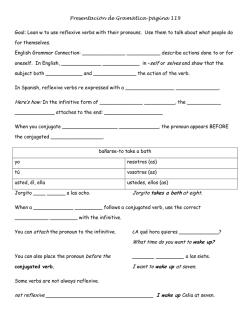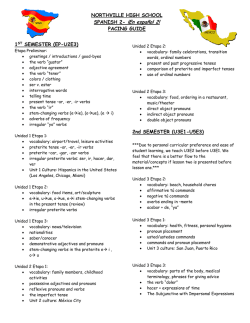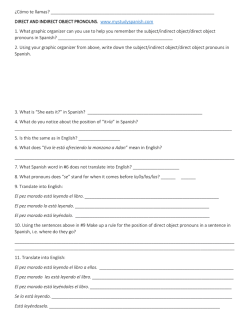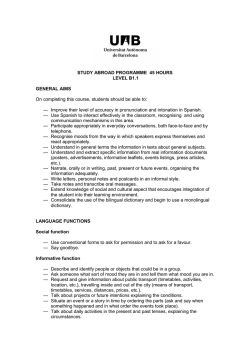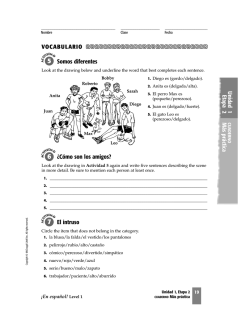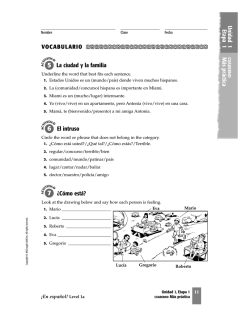
REGULAR INFORMAL COMMANDS (TÚ)
UNIDAD 3 ETAPA 2 – WS#1 NOMBRE: REGULAR INFORMAL COMMANDS (TÚ) Positive TÚ commands: 1. Drop the ending (ar, er, or ir). 2. Add the appropriate third person singular in the present indicative. AR – a ER – e IR – e 3. Place the subject (tú) after the command. Give the affirmative tú command for each of the following verbs. 1. bailar 9. caminar 2. alquilar 10. lavar 3. limpiar 11. traer 4. doblar 12. abrir 5. acompañar 13. pagar 6. leer 14. esperar 7. beber 15. cambiar 8. contester 16. enseñar Give the affirmative tú command for the following verbs with irregular spellings and then write a command to do something. 1. hacer 2. ser 3. ir 4. decir 5. poner 6. salir 7. tener 8. venir haz ¡haz la tarea! UNIDAD 3 ETAPA 2 – WS#2 NOMBRE: TÚ COMMANDS WITH PRONOUNS (DIRECT OBJECT PRONOUNS) Pronouns are attached to the end of positive commands. When attached to the end of a positive command an accent is needed on the second-to-last syllable of the verb. The exception to this is when the command is a single syllable word and only one pronoun is added. When there are two pronouns in a sentence the word order is “reflexive + direct” or “indirect + direct.” EX: callarse cállate dar da dame (give me) dámelo (give it to me) 1. Reflexive pronouns (me, te, se, nos, os, se) are used to show action done to oneself. 2. Indirect object pronouns (me, te, le, nos, os, les) are used when there is an indirect object in the sentence. The indirect object receives the direct object. 3. Direct object pronoun (me te, lo, la, nos, os, los, las) are used to replace a direct object. The direct object receives the action of the verb. Give the TÚ command for the verb and change the object to a direct object pronoun. 1. (caminar) 2. (poner) 3. (llevar) 4. (pasar) 5. (sacar) 6. (planchar) la camiseta UNIDAD 3 ETAPA 2 – WS#3 NOMBRE: TÚ COMMANDS WITH PRONOUNS (REFLEXIVE PRONOUNS) Pronouns are attached to the end of positive commands. When attached to the end of a positive command an accent is needed on the second-to-last syllable of the verb. The exception to this is when the command is a single syllable word and only one pronoun is added. When there are two pronouns in a sentence the word order is “reflexive + direct” or “indirect + direct.” Reflexive pronouns (me, te, se, nos, os, se) are used to show action done to oneself. EX: Peinarse ¡Péinate! Ponerse ¡Ponte! Write the affirmative tú command for each reflexive verb. 1. 2. 3. 4. 5. 6. 7. 8. UNIDAD 3 ETAPA 2 – WS#4 NOMBRE: TÚ COMMANDS WITH PRONOUNS (REFLEXIVE, REFLEXIVE AND DIRECT) Translate the sentences to Spanish using an affirmative tú command. Then write the affirmative command with the pronouns (direct, indirect, reflexive). 1. Put on your clothes! 2. Get up! 3. Write the vocabulary! 4. Wash the disher! 5. Set the table! 6. Sit down! 7. Go to bed! 8. Vacuum the bedroom! 9. Sweep the floor! 10. Cut the grass! 11. Wash your face! 12. Dry your hair! 13. Clean the car! 14. Brush your teeth! 15. Be quiet! 16. Take out the trash! 17. Fill the ice-cooler! 18. Use the towel! 19. Read the book! 20. Take off your shoes! UNIDAD 3 ETAPA 2 – WS#5 NOMBRE: NEGATIVE INFORMAL COMMANDS (TÚ) Negative TÚ commands: 1. Conjugate the verb into the present tense YO form. 2. Drop the ending -o. 3. Add the appropriate ending. a. Ar verbs – e b. Er & Ir verbs – a 4. Negative pronouns are placed in FRONT of the tú command. Give the negative tú command for each of the following verbs. 1. correr 9. barrer 5. cortar 10. lavar 6. limpiar 11. trabajar 7. doblar 12. pasar 8. planchar 13. comer 9. escuchar 14. usar 10. 15. contestar tomar 11. fumar 16. romper Give the negative tú command for the following verbs with irregular spellings and then write a command to do something. 1. hacer 2. ser 3. ir 4. decir 5. poner 6. salir 7. tener 8. venir hagas ¡No hagas eso! Unidad 3 Etapa 2 - WS#6 Nombre: NEGATIVE TÚ COMMANDS WITH PRONOUNS (DIRECT OBJECT PRONOUNS) Pronouns are not attached, but placed before the negative commands. When there are two pronouns in a sentence the word order is “reflexive + direct” or “indirect + direct.” EX: tomar la prueba no la tomes dar me la loción no des no me des (do not give me) no me la des (do not give it to me) 4. Reflexive pronouns (me, te, se, nos, os, se) are used to show action done to oneself. 5. Indirect object pronouns (me, te, le, nos, os, les) are used when there is an indirect object in the sentence. The indirect object receives the direct object. 6. Direct object pronoun (me te, lo, la, nos, os, los, las) are used to replace a direct object. The direct object receives the action of the verb. Give the negative TÚ command for the verb and change the object to a direct object pronoun. 1. 2. 3. 4. 5. 6. 7. 8. (sacar) (poner) (ver) (limpiar) (escuchar) (hacer) (cortar) (jugar) UNIDAD 3 ETAPA 2 – WS#7 NOMBRE: NEGATIVE TÚ COMMANDS WITH PRONOUNS (REFLEXIVE PRONOUNS) Pronouns are not attached but are placed before positive commands. When attached to the end of a positive command an accent is needed on the second-to-last syllable of the verb. The exception to this is when the command is a single syllable word and only one pronoun is added. When there are two pronouns in a sentence the word order is “reflexive + direct” or “indirect + direct.” Reflexive pronouns (me, te, se, nos, os, se) are used to show action done to oneself. EX: levantarse ¡No te levantes secarse ¡No te seques! Write the negative tú command for each reflexive verb. 1. (ponerse) 2. (cepillarse) 3. (levantarse) 4. (arreglarse) 5. (aconsejarse) 6. (acostarse) 7. 8. (entrenarse) (mantenerse sano) UNIDAD 3 ETAPA 2 – WS#8 NOMBRE: TÚ COMMANDS WITH PRONOUNS (REFLEXIVE, REFLEXIVE AND DIRECT) Translate the sentences to Spanish using an negative tú command. Then write the affirmative command with the pronouns (direct, indirect, reflexive). 1. Don’t put on your clothes! 2. Don’t stand up! 3. Don’t write the vocabulary! 4. Don’t wash the disher! 5. Don’t set the table! 6. Don’t sit down! 7. Don’t go to bed! 8. Don’t clean the bedroom! 9. Don’t sweep the floor! 10. Don’t cut the grass! 11. Don’t wash your face! 12. Don’t dry your hair! 13. Don’t clean the car! 14. Don’t brush your teeth! 15. Don’t make the sandwiches! 16. Don’t take out the trash! 17. Don’t fill the ice-cooler! 18. Don’t use the towel! 19. Don’t read the book! 20. Don’t play baseball! ¡No pongas! ¡No las pongas! UNIDAD 3 ETAPA 2 – WS#9 NOMBRE: ADVERBS ENDING IN –MENTE Adverbs tell you how an action takes place. To make this type of adverb, add –mente to the feminine form of the adjective. Some forms do not have a masculine / feminine forms, so just add –mente to the end. EX: Rápido Rápida Rápidamente Translate the following sentence into Spanish using the adverbs ending in –mente. 1. I recently went to the library. 2. The students speak Spanish slowly. 3. She frequently goes to the movies. 4. John immediately does his homework when he gets home. 5. We typically have hamburgers with cheese. 6. María and Juana slowly walked to the super market. 7. I normally run in the morning. 8. Unfortunately, Selena lost her book. 9. We especially like to eat ice-cream when it’s hot. 10. You easily did your project.
© Copyright 2024
